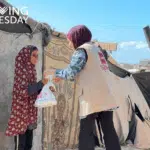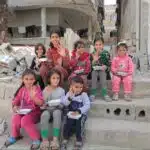Donate to Pakistan: Best Guide 2025
Why Pakistan Needs Your Support Now More Than Ever
Donate to Pakistan efforts have become critically important following devastating floods that affected over 33 million people – nearly one in seven Pakistanis. Your support can provide critical aid to address the most urgent needs:
- Clean water and sanitation (669,675 people need access)
- Food aid (45% increase in hunger since floods)
- Medical care (waterborne diseases spreading)
- Shelter for displaced families
- Child nutrition programs
Pakistan faces a perfect storm of challenges. The 2022 floods were the worst in decades, killing over 1,300 people including nearly 500 children. More than 4.4 million acres of crops were destroyed, and over 1.1 million livestock perished. The country produces less than 1% of global carbon emissions yet suffers some of the worst climate impacts.
Children are especially vulnerable. With a malnutrition rate of 17.7% – above emergency thresholds – and 35% of children out of school, the crisis extends far beyond immediate flood relief. Waterborne diseases like cholera and dengue are spreading rapidly in flood-affected areas where clean water systems were destroyed.
The scale is staggering: one-third of the country was submerged at the peak of flooding. Recovery will take years, not months, making sustained support crucial for long-term rebuilding efforts.
As Caroline Evashavik, I’ve helped grow UMR’s social media following by 3,233% while managing campaigns that generate over $500,000 in seasonal revenue, giving me deep insight into effective strategies to donate to Pakistan and maximize donor impact. My experience in digital engagement and data analytics helps identify the most transparent and effective organizations working in Pakistan’s humanitarian landscape.
Understanding the Crisis: Why Your Donation is Crucial
Pakistan faces one of the world’s most heartbreaking injustices. This nation of incredible resilience contributes less than 1% to global carbon emissions, yet it ranks among the ten countries most devastated by climate change. The people of Pakistan are paying a devastating price for a crisis they didn’t create.
The 2022 floods were a wake-up call that shook the world. One-third of the entire country disappeared underwater. But floods are just part of the story – Pakistan also battles severe droughts, destructive cyclones, and extreme weather that seems to grow worse each year.
These disasters don’t just destroy buildings and roads. They tear apart the very foundation of how families survive. When the floods hit, hunger skyrocketed by 45%, leaving over 8.6 million people facing crisis levels of food insecurity. That’s on top of the 16% of Pakistanis who were already struggling to find enough to eat.
The path to recovery stretches far beyond emergency relief. Families need to rebuild their homes from scratch. Communities must repair vital infrastructure like hospitals and schools. People need help creating new ways to earn a living when their farms and businesses are gone.
When you donate to Pakistan, you’re supporting this long journey back to stability. UMR focuses on the essential building blocks communities need: healthcare that saves lives, clean water that prevents disease, education that gives children hope, and livelihood support that helps families stand on their own feet again.
More info about the devastating floods
Understanding the Most Pressing Needs Before You Donate to Pakistan
Before you donate to Pakistan, it helps to understand what families on the ground need most urgently. The recent floods created a complex web of challenges that require both immediate action and long-term solutions.
Shelter tops the list of urgent needs. Over one million homes were destroyed or badly damaged, forcing 33 million people to flee with nothing but the clothes on their backs. Emergency shelter provides the first step toward safety and dignity for displaced families.
Clean water becomes a matter of life and death when flood waters contaminate drinking supplies. With water systems destroyed, communities face the terrible choice between thirst and drinking contaminated water that spreads cholera, dengue, malaria, and other dangerous diseases. Deep water wells can serve entire communities for years, providing a sustainable source of safe drinking water.
Food shortages hit Pakistan hard when floods destroyed 4.4 million acres of crops and killed 1.1 million livestock. Agricultural families lost both their food source and their income in one devastating blow. Emergency food supplies keep families fed in the short term, while programs that help farmers rebuild offer hope for the future.
Medical aid saves lives in multiple ways. Beyond treating flood injuries, healthcare workers battle the spread of waterborne diseases that thrive in post-flood conditions. UMR’s healthcare programs include everything from general medical care to specialized services like cataract surgeries that restore sight and independence.
Livelihood support helps families rebuild their financial independence. Cash grants let families buy what they need most while supporting local businesses. Longer-term projects like honey bee farms, sewing machines, or livestock provide sustainable ways for families to earn income and regain their dignity.
More info about water projects
The Specific Challenges Faced by Children
Children in Pakistan face some of the world’s most heartbreaking challenges. The numbers tell a story that demands urgent action.
The 2022 floods claimed the lives of nearly 500 children. But even beyond disasters, childhood in Pakistan remains dangerous – 1 in 14 children dies before their 5th birthday, a rate ten times higher than in the United States.
Malnutrition affects children at alarming rates. Pakistan’s acute malnutrition rate of 17.7% exceeds emergency thresholds, while 38% of children suffer from stunting that damages their physical and mental development for life. These aren’t just statistics – they represent millions of children whose potential is being stolen by hunger.
Education remains out of reach for too many children. The floods damaged or destroyed schools serving 11 million children. Even before the disaster, 35% of children weren’t in school. Girls face the greatest barriers – 53% of girls aged 15 and older struggle to read and write.
Child protection becomes even more critical during crises. Vulnerable children face increased risks of violence, exploitation, and early marriage. The fact that 14% of girls aged 15-19 are already married shows how poverty and crisis push families toward desperate choices.
Health threats multiply in flood-affected areas where clean water disappears and diseases spread rapidly. Children’s developing immune systems make them especially vulnerable to cholera, dengue, and other waterborne illnesses.
UMR addresses these challenges through comprehensive programs. Our education support ensures children can continue learning even during crises. Our healthcare programs focus on improving child nutrition and providing essential medical care. We believe every child deserves a healthy start and the chance to build a brighter future.
More info about child protection efforts
General country statistics from the CIA World Factbook
How to Effectively Donate to Pakistan and Ensure Your Contribution Counts
When you decide to donate to Pakistan, you want to be absolutely certain your generosity creates real change for families who desperately need it. The difference between a donation that truly helps and one that gets lost in overhead costs often comes down to choosing the right organization.
The key is understanding how to research charities properly. You’ll want to look at their transparency, see proof of their impact, and understand whether they’re legitimate organizations that will use your money wisely. It’s not as complicated as it might sound, but taking a few extra minutes to do your homework can make your donation far more powerful.
Types of Aid Organizations and Their Focus
The humanitarian landscape in Pakistan includes organizations of all sizes, each bringing different strengths to the table. Understanding these differences helps you choose where your donation will have the biggest impact.
Large humanitarian organizations typically have extensive global networks and can mobilize resources quickly during emergencies. These groups often focus on immediate disaster response – things like emergency shelter, food distribution, and medical aid. They have the infrastructure to reach thousands of people rapidly when disasters strike.
Local Pakistani charities bring something equally valuable: deep community knowledge and cultural understanding. These organizations know exactly which families need help most and can steer local customs and languages seamlessly. Many have been serving their communities for decades, building trust and relationships that international groups simply can’t replicate overnight.
Some organizations focus specifically on emergency relief – getting people through the immediate crisis with food, water, and shelter. Others concentrate on long-term development projects like building schools, training teachers, or helping farmers develop sustainable income sources.
Healthcare-focused groups tackle everything from treating waterborne diseases to providing specialized surgeries. Education-centered organizations work to get children back in school and provide learning materials.
At UMR, we’ve found that the most effective approach combines immediate relief with long-term solutions. Our transparent, sustainable aid and impactful partnerships mean we can respond quickly to emergencies while also building lasting change in communities.
Vetting Charities: How to Make a Safe Donation to Pakistan
Making a safe donation starts with asking the right questions. You wouldn’t buy a car without checking under the hood, and you shouldn’t donate to Pakistan without understanding where your money actually goes.
Financial transparency should be your first checkpoint. Reputable charities openly share how they spend donations. Look for organizations where at least 87 cents of every dollar goes directly to programs rather than administrative costs. This information should be easy to find on their website – if you have to hunt for it, that’s a red flag.
Program efficiency goes beyond just percentages though. You want to see real evidence of impact. Does the charity share specific stories about families they’ve helped? Can they tell you exactly how many children received clean water or how many homes were rebuilt? Numbers and stories together paint the clearest picture of whether an organization is making a difference.
Registration status matters enormously for both legitimacy and your wallet. For US donors, 501(c)(3) status makes your donation tax-deductible and indicates the organization meets federal nonprofit standards. International donors should check their local tax laws to understand potential benefits.
Impact reports separate serious organizations from those just going through the motions. Quality charities publish detailed reports showing what they accomplished, what challenges they faced, and how they’re improving their work. These reports should be recent, specific, and honest about both successes and setbacks.
Donor reviews and third-party ratings provide additional peace of mind. Organizations rated by independent evaluators have submitted to scrutiny beyond what’s legally required. While not every excellent charity has formal ratings, those that do have demonstrated extra commitment to accountability.
Finally, look for charities with low overhead and direct-to-beneficiary programs. The best organizations minimize layers between your donation and the people who need help. At UMR, our focus on impactful partnerships means we work directly with communities to ensure aid reaches those who need it most.
Give with confidence by checking charity ratings
Maximizing Your Impact: Smart Ways to Give
When you decide to donate to Pakistan, the way you give can be just as important as what you give. Smart giving isn’t just about opening your wallet – it’s about understanding how different approaches can multiply your impact and create lasting change for families in need.
Choosing Your Donation Method
Every donor is different, and thankfully, there are several meaningful ways to support Pakistan’s recovery efforts. Each method has its own advantages, and the best choice depends on your personal situation and giving goals.
Monthly donations offer incredible power for organizations working in Pakistan. When you commit to giving regularly – even just $25 or $50 each month – you’re providing something invaluable: predictability. This steady income allows humanitarian groups to plan long-term projects like building schools or digging water wells, rather than just responding to emergencies. Monthly givers often see deeper impact because their sustained support helps families rebuild their lives completely, not just survive the immediate crisis.
One-time donations are perfect when you want to respond quickly to urgent needs or when a specific project captures your heart. These contributions are essential during emergencies – like when floods hit and thousands need immediate shelter and clean water. The flexibility of one-time giving means you can contribute when it feels right for your budget and circumstances.
Project-based giving lets you connect directly with specific initiatives. Maybe you’re passionate about education and want to fund a classroom in a flood-affected area, or perhaps clean water access speaks to your heart and you’d like to sponsor a community well. This targeted approach helps you see exactly where your money goes and often comes with updates about the specific project you’ve supported.
Zakat and Sadaqah donations hold special significance for Muslim donors. Many organizations, including UMR, ensure these contributions meet Islamic guidelines and are distributed appropriately to those most in need. This faith-based giving adds spiritual meaning to your humanitarian support.
In-kind donations – like sending clothes or medical supplies – might seem helpful, but here’s something important to know: cash donations are almost always more effective. Shipping costs can eat up much of your contribution’s value, and local communities benefit more when organizations can purchase supplies locally, supporting regional economies while meeting specific needs.
The beauty of giving to donate to Pakistan efforts is that there’s no wrong way to help – only ways that might be more or less effective for your situation and goals.
Understanding Tax Benefits for International Donors
Nobody likes leaving money on the table, especially when you’re trying to help others. Understanding the tax benefits of your charitable giving can help you give more effectively and maybe even increase your total contribution.
For U.S. donors, the key is finding organizations with 501(c)(3) status. This designation means your donation is tax-deductible, potentially reducing your tax burden while supporting vital humanitarian work. When you donate to Pakistan through qualified organizations, you’re not just helping families overseas – you’re also making a smart financial decision for your own household.
Keep detailed records of all your contributions. Save receipts, confirmation emails, and any documentation the organization provides. Many donors are surprised to learn they can deduct not just cash donations, but also expenses related to volunteer work, like travel costs to charity events.
Employer matching programs can double your impact without costing you anything extra. Many companies will match their employees’ charitable contributions, sometimes up to several thousand dollars per year. Check with your HR department – you might find your $100 donation to Pakistan relief efforts automatically becomes $200.
Timing matters for tax benefits. If you’re planning a larger contribution, consider whether making it before December 31st will help your current year’s tax situation, or if waiting until January might be more beneficial.
Different countries have varying rules about international charitable giving, so it’s worth consulting with a tax professional if you’re making substantial contributions. The goal is to maximize both your impact on Pakistani communities and your own financial well-being.
While tax benefits are nice, they’re just the cherry on top. The real reward comes from knowing your generosity is helping families rebuild their lives with dignity and hope.











